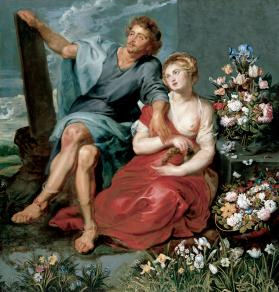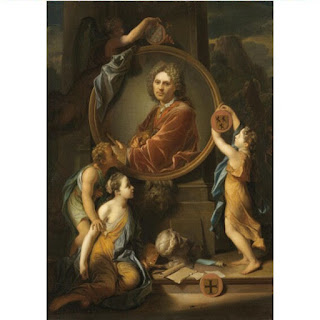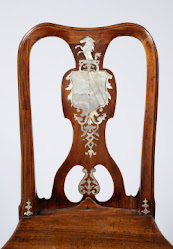Sir Gregory Page, second baronet (1689–1775) Art Collector and Patron
Sir Gregory Page, second baronet (1689–1775)
Art Collector and Patron
 |
| Peter Paul Rubens Pausius and Glyceira ex collection Sir Gregory Page 2nd Bt |
Sir Gregory Page 2nd Bt 1689-1775 was extremely wealthy by the time his father died in 1720. He inherited £600,000 and was wealthy in his own right. He was, for example, a large stockholder in the East India Company, having opened his own account on the 30th. March 1709 (the year after his 21st. birthday) and was appointed a director of the company in 1719 and 1720 (the year his father died). His account was not closed until the year before his death in 1774. Sir Gregory also held East India 3.1/2 % Annuities (later 3%) from the 22nd. January 1753 to the 19th. December 1781 (which stood in his name, though owned by his trustees, for some six years after his death. Whereas the main thrust of the first baronet, had been mainly to build up a large fortune through trade and commerce, his son, the second baronet, took a quite different course. This may, to some small or large extent, have been dictated by the family's new station in life. The Pages were by now a well-established part of the Gentry, and with a title; and the gentry by tradition, had always been owners of land. So young Gregory in 1717 (three years before the death of his father) set about correcting this deficiency and made the first of many purchases, that would eventually place the family, among some of the largest landowners in the country.
The Wricklemarsh Estate was to become the 2nd. baronets "jewel in the crown", his most prized possession and passion: the vast tracts of land already acquired, were an investment and safe haven for his growing wealth. But Wricklemarsh was for himself. It must have been in 1722 or early 1723, that Sir Gregory and his wife Martha (a year or more after their marriage) decided to quit the Red House. Sir Gregory embarked on building a magnificent Palladian Mansion in place of the old Wricklemarsh House formerly owned by Sir John Morden. His architect for the new Wricklemarsh House was to be John James (1672—1746) and perhaps a curious choice, for Sir Gregory could well have afforded one of the well—known fashionable architects of the time, Campbell, Kent or indeed the Earl of Burlington, but it is possible none of these were available or could meet with Sir Gregory's hectic and tight schedule, for from the time of purchase in August 1723, the old house had to be pulled down and the new one built. It is well recorded, that within 11 months of the date of the start, the house was completed, and we know Sir Gregory had taken up residence by the end of 1724. To have achieved this incredible feat, considering the size of the house, let alone the difficult winter period, when building might cease for days at a time, the army of builders and landscapers, defies all imagination.

By 1724 Sir Gregory and his wife took possession of their new mansion and started to fill the walls and interiors with a magnificent collection of paintings, furniture, silver, and porcelain. We have a number of contemporary accounts and lists detailing what was in the collection followed by Christie's sales catalogues of the sale of the contents of the house, The picture collection was sold in parts in 1775, 1783, and 1787. Wricklemarsh was sold in 1784 to John Cator, who instructed Christie's to auction the materials of the house in 1787; its shell was finally demolished in 1800. Horace Walpole (later fourth Earl of Oxford), wrote in 1779 that 'half the van der Werffs, which cost an immense sum … are spoiled since Sir Gregory Page's death by servants neglecting to shut out the sun' (Horace Walpole's Correspondence, ed. W. S. Lewis, 33, 1965, p. 137).
George Vertue describes his visit On the 2nd June 1741, accompanied by his patron the Earl and Lady • Oxford, Vertue went to see Sir Gregory Page's house, and he described the view from the house and the collection of paintings inside: .... from the open under a noble pediment, supported with columns — presents the finest prospect...ever seen in the distant country and pleasant rising hills - turning into the house again the first room beautifully adorned — is hung round with the excellent paintings by that famous painter lately living In Holland, P. Van der Werf. Kt. whose pictures th'o (sic) small, are of immense value. This collection being but twelve pieces cost several thousand pounds sterling there are also with them four pieces of flowers and fruit by another late famous painting in Holland..,.Van Huysum.

Section of the Interior of Wricklemarsh from Vitruvius Britanicus
James Dodsley details the the paintings in the interior of Wricklemarsh indicating the location and quantity of paintings are as follows :
Drawing room 13 pictures
Saloon 8 pictures
Dressing room 32 pictures
Bed chamber 1 picture
Library 1 picture
Dining room 2 pictures
Attic 9 pictures












Sir Gregory also patronized contemporary artists. The most notable artist was Van Huysum. He commissioned 6 paintings from Van Huysum towards the end of his career. Sir Gregory was also a personal friend of Adrian Van der Werff of which 8 paintings were purchased by the Louvre in Paris from the sale of the paintings from Sir Gregory's collection. He also owned a painting by Hendrik van Limborch "Infants decorating a stone cartouche framing a copy of a self-portrait by Adriaen van der Werff."

Hendrik van Limborch Infants decorating a stone cartouche
framing a copy of a self-portrait by Adriaen van der Werff
formerly in the collection of Sir Gregory Page 2nd Bt
The following Ten Pictures were purchased from the Artist, Adrian Van der Werff a short time before his death by Sir Gregory Page 2nd Bart: Hercules and Dejanira, The Virgin at the Tomb, A Magdalen, The Nativity, The Finding of Moses, Seleucus and Stratonice, Joseph and Potiphar's Wife, Venus and Cupid, Roman Charity. and A Faun and two Nymphs. Horace Walpole (later fourth earl of Oxford), wrote in 1779 that 'half the van der Werffs, which cost an immense sum … are spoiled since Sir Gregory Page's death by servants neglecting to shut out the sun' (Horace Walpole's Correspondence, ed. W. S. Lewis, 33, 1965, p. 137).

LUCA GIORDANO History of Cupid & Psyche
one of a set of 12 now in the Royal collection
A set of twelve paintings by Giordano telling the story of Cupid and Psyche, at that time owned by Sir Gregory Page 2nd Bt are now in the Royal Collection and were mentioned by Horace Walpole when he visited Sir Gregory Page's house :
"I was at Blackheath t’other morning, where I was grieved. There are eleven Vander Werffs that cost an immense sum: half of them are spoiled since Sir Gregory Page’s death by servants neglecting to shut out the sun. There is another room hung with the history of Cupid and Psyche, in twelve small pictures by Luca Giordano, that are sweet. There is, too, a glorious Claude, some fine Teniers, a noble Rubens and Snyders, two beautiful Philippo Lauras, and a few more,--and several very bad. The house is magnificent, but wounded me; it was built on the model of Houghton, except that three rooms are thrown into a gallery."
Some more examples of paintings that were formerly in the collection of Sir Gregory Page 2nd Bt can be seen in many galleries around the world and private collections, here are just a few examples.

Frans Snyders (Flemish, 1579 - 1657) Kitchen still life Getty museum

Jacopo Bosano Annunciation to the Shepherds

Jan Van Huysum still life

Paul Veronese Moses & Pharaoh's daughter

Peter Paul Rubens June and Ixion The Louvre Paris

Peter Paul Rubens Pausias and Glycera

Peter Paul Ruebens the three graces Dulwich Picture Gallery

Sir Anthony Van Dyck, Samsonand Delilah Dulwich Art Gallery

Vaste Castello Moses striking the Rock
Sir Gregory also collected fine furniture porcelain and silver some of these items can be fund in pubic collections and a few items have appeared at auction in recent years.



A set of six chairs of Dutch East India wood inlaid with the Page-Kenward arms
The rosewood chairs from the Andaman Islands in the Indian Ocean were commissioned by Sir Gregory Page, he had the set of chairs made and inlaid with mother-of-pearl to celebrate his marriage to Martha Kenward in 1721. The set of six chairs of Dutch East India wood inlaid with the Page-Kenward arms in mother-of-pearl can be seen at the John Soane Museum in Lincoln Inn Fields, London, today. They came from Wricklemarsh and were probably acquired by Sir John Soane about l784 at the time of his marriage. The arms of Sir Gregory Page Bt were “azure, a fess indented between 3 martlets or “and those of his lady (Martha Kenward) indented between 3 martlets or" and those of his lady (Martha Kenward) were “azure, on a bend or a roses gules between 3 cross-crosslets fitchee argent. One of a set of eight (XF296-XF303). With hooped backs, dished top rail, and single splat; splayed front legs with pad feet, the knees decorated with lambrequin ornament with acanthus; the aprons with a central cartouche flanked and surmounted by acanthus scrolls; curved struts extend from the apron of each chair to the back stretcher with a bracket from this to the base of the center of the front apron; the chairs originally had cane seats which have been replaced by thin mahogany. The splats are inlaid with a coat of arms, each composed in a slightly different way, with different elements either made from separate, inlaid pieces of mother-of-pearl or engraved onto larger pieces; the engraved decoration has traces of mastic, originally used to embolden the lines, surviving in many places. The bottoms of the back uprights, the splats, and the tops of the feet are inlaid with further floral motifs.
These chairs conform to an English pattern with a splat and a dished top rail with a moulding running round but with various non-European features. In order for such furniture to be produced, patterns and models of European furniture were sent out to the Far East for copying by Chinese makers. The joinery has certain characteristics of Chinese cabinet work, in particular the ‘cogged scarf joint’ which joins the sections of the seat rail, the way the seat rail is through-tenoned and pinned to the rear upright (no European chair would have diagonal joints such as those on the corners at the top of the back), the absence of a shoe for the base of the splat, the beaded edge to the seat and uprights and the rather rough-hewn aspect of the S-shaped seat brace. The quality of the mother-of-pearl and the way it is incised recalls the Chinese gaming counters, often decorated with armorial designs, which were a staple of the China trade in the eighteenth century.
Rosewood chairs inlaid with mother-of-pearl are first mentioned as being imported from China in the customs records for 1725-1726. Such pieces were special commissions for individual westerners as none of the European companies dealt with furniture after about 1720.
Dr. Adam Bowett suggests that the form of these chairs is probably derived from the Sgabello type rather than from the X-frame and that they might have been designed as hall chairs, a notion reinforced by the construction of the lower frame with its single arched fore-and-aft stretcher: the standard method of construction used on English hall chairs. The presence of coats of arms in the back also tends to suggest hall chairs.
The arms are those of Sir Gregory Page of Wricklemarsh, Kent, impaled with those of his wife Martha, née Kenward, of Yalding, also in Kent. They married in 1721, which gives a terminus post quem for the chairs. Sir Gregory was a South Sea millionaire as well as, like his father and grandfather, a director of the East India Company (1719–20) of which he was a large stockholder. Soon after his marriage, in 1723, he bought the freeholding of Wricklemarsh on Blackheath and, from 1723-4, he built Wricklemarsh House to the designs of John James. Sir Gregory died in 1775 and the property was inherited by his great-nephew Sir Gregory Turner, who took the name and arms of Page to become Sir Gregory Page-Turner. He auctioned off the contents of the house and then sold it to John Cator, a property speculator. It was dismantled in 1787 when the materials were sold by auction by Christie’s, leaving it a ruin.6
The 1783 sale included much else in the 'oriental' taste represented by these chairs, including ivory pagodas, ‘Chinese Japan armchairs’, a pair of beautiful jewel cabinets, fine old black and gold Japan’, and ‘two pair of Chinese clay figures on gilt brackets.’ While these were to be found in the principal rooms and featured early in the sale, the rosewood and mother-of-pearl chairs languished in the ‘Stewards Bed Chamber and Rooms Adjoining’, and were sold on the fourth day in what was very much the ‘lumber’ end of the sale. They were catalogued as:
Ten rosewood chairs with a crest in mother of pearl faulty and cushions.
The demolition of Wricklemarsh, one of the great private palaces of the eighteenth century, attracted much attention. Soane ‘went to Sir Gregory Page's to look at materials’ on 29 May 1787 and bought salvageable building materials at the sale on behalf of one of his clients, Robert Fellowes of Shotesham, presumably for use there. This Journal reference has led previous researchers to assume that Soane must have acquired the eight Chinese chairs at the same time, in 1787, but they are more likely to be from the set of ten that were included in the 1783 sale. The chairs are not noted in Soane’s collection until June 1819 when one appears in a view of his first picture gallery. Since around 1825 the chairs have stood where they remain, lined up along the west wall of the Library, presumably arranged for display rather than use. This is a place of honour in the principal reception room of the house, and Soane obviously valued them highly, unlike the author of an article in The Cabinet Maker, 1880, who commented that they ‘are too ugly for illustration or reproduction’

The parlour chairs, conceived in the George I 'India' [Chinese] manner have their rectilinear 'banister' splats heraldically charged with the 'horse' crest of Sir Gregory Page-Turner, 2nd Bt., (d. 1775) of Wricklemarsh, Blackheath, Kent. His father, Sir Gregory Page-Turner, 1st Bt., (d. 1720) was created 1st baronet by George I in 1714 and was a director and later chairman of the East India Company. Sir Gregory Page-Turner, 2nd Bt., was a director of the East India Company from 1719-20. Christie's sold the contents of Wricklemarsh in a house sale 23-29 April 1783. There were are number of chairs in this sale, however based on the very brief descriptions in the sale catalogue it has not been possible to identify the present examples. Ten Anglo-Chinese padouk chairs inlaid in mother-of-pearl with the Page-Turner arms, are identifiable and were sold in the Wricklemarsh house sale, lot 50. Six of these chairs are now in the Sir John Soane Museum, London. A pair of George I japanned hall chairs painted with the Page-Turner arms also sold in the Wricklemarsh sale, lot 69. These chairs were sold again at Christie's London, 15 November 1990, lot 69. The Page-Turner crest also features on a chair acquired in 1959 by the Victoria and Albert Museum (C. Gilbert and T. Murdoch, John Channon and brass-inlaid furniture 1730-1760, London, 1993.




Three large Chinese Imari Armorial services Kangxi period, 1662-1722, were commissioned by the following interconnected families :
Sir Gregory Page 1st Bt & his wife Mary nee Trotman
Sir Edward Turner and his wife Mary (Sir Gregory's daughter)
Sir Gregory Page 2nd Bt (son of Sir Gregory. ( examples shown above.)
These three services which included, plates, soup plates, chargers Pint and Quart Tankards, and other items can be seen in various private collections. They are referred to in David Howard's comprehensive book on Chinese Armorial porcelain. Sir Gregory Page 2nd Bt and Edward Turner through his marriage to Mary Page were families who both had directors on the East India Company and it is logical to conclude that they collectively commissioned these through their contacts in the East India Company in the 1717-1718 period.



Comments
Post a Comment
Please leave any interesting factual comments relating to the post(s)